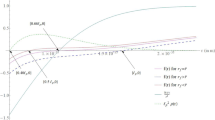Abstract
The work is devoted to studying the vacuum structure, special relativity, electrodynamics of interacting charged point particles and quantum mechanics, and is a continuation of [6, 7]. Based on the vacuum field theory no-geometry approach, the Lagrangian and Hamiltonian reformulation of some alternative classical electrodynamics models is devised. The Dirac type quantization procedure, based on the canonical Hamiltonian formulation, is developed for some alternative electrodynamics models. Within an approach developed a possibility of the combined description both of electrodynamics and gravity is analyzed.
Similar content being viewed by others
References
V. I. Arnold, Mathematical Methods of Classical Mechanics (Springer,(New York, 1978).
R. Abraham and J. Marsden, Foundations of Mechanics (Benjamin, Cummings, Massachusetts, 1978).
N. N. Bogolyubov and D. V. Shirkov, Quantum Fields (Nauka, Moscow, 1984).
R. Feynman, Lectures on Gravitation, Notes of California Inst. of Technology (1971).
R. Feynman, R. Leighton, and M. Sands, The Feynman Lectures on Physics. Electrodynamics, vol. 2 (Addison-Wesley, MA, 1964).
A. K. Prykarpatsky, N. N. Bogolyubov, Jr., and U. Taneri, “The Vacuum Structure, Special Relativity and Quantum Mechanics Revisited: A Field Theory No-Geometry Approach,” Theor. Math. Phys. 160, 1079–1095 (2009); arXiv lanl:0807.3691v.8 [gr-gc] (2008).
A. K. Prykarpatsky, N. N. Bogolyubov, Jr., and U. Taneri, “The Field Structure of Vacuum, Maxwell Equations and Relativity Theory Aspects,” Preprint ICTP, IC/2008/051 (Trieste, 2008); http://publications.ictp.it.
A. Prykarpatsky and I. Mykytiuk, Algebraic Integrability of Nonlinear Dynamical Systems on Manifolds: Classical and Quantum Aspects (Kluwer Acad., Netherlands, 1998).
W. Thirring, Classical Mathematical Physics, 3rd ed. (Springer, 1992).
P. A. M. Dirac, The Principles of Quantum Mechanics, 2nd ed. (Clarendon, Oxford, 1935).
L. D. Landau and E. M. Lifshitz, Course of Theoretical Physics, Vol. 2: The Classical Theory of Fields (Nauka, Moscow, 1973; Pergamon, Oxford, 1975).
L. D. Landau and E. M. Lifshitz, Course of Theoretical Physics, Vol. 3: Quantum Mechanics: Non-Relativistic Theory (Nauka, Moscow, 1974; Pergamon, New York, 1977, 3rd ed.).
N. Bogolyubov and D. Shirkov, Introduction to the Theory of Quantized Fields (Interscience, New York, 1959).
L. Brillouin, Relativity Reexamined (Academic, New York, London, 1970).
L. D. Faddeev, “Energy Problem in the Einstein Gravity Theory,” Russ. Phys. Surv. 136, 435–457 (1982).
J. Marsden and A. Chorin, Mathematical Foundations of the Mechanics of Liquid (Springer, New York, 1993).
P. I. Holod and A. I. Klimyk, Mathematical Foundations of Symmetry Theory (Naukova Dumka, Kyiv, 1992) [in Ukrainian].
O. Repchenko, Field Physics (Galeria, Moscow, 2005).
C. H. Brans and R. H. Dicke, “Mach’s Principle and a Relativistic Theory of Gravitation,” Phys. Rev. 124, 925 (1961).
S. Deser and R. Jackiw, “Time travel?” arXiv:hep-th/9206094 (1992).
G. Dunner and R. Jackiw, “’Peierles Substitution’ and Chern-Simons Quantum Mechanics,” arXiv:hep-th/92004057 (1992).
R. Jackiw and A. P. Polychronakos, “Dynamical Poincare Symmetry Realized by Field-Dependent Diffeomorhisms,” arXiv:hep-th/9809123 (1998).
F. Wilchek, “QCD and Natural Philosophy,” Ann. Henry Poincare 4, 211–228 (2003).
I. Bialynicky-Birula, Phys. Rev. 155, 1414 (1967); Phys. Rev. 166, 1505 (1968).
H. Kleinert, Path Integrals, 2nd ed. (World Sci., Singapore, 1995), p. 685.
I. A. Klymyshyn, Relativistic Astronomy (Naukova Dumka, Kyiv, 1980) [in Ukrainian].
A. A. Logunov and M. A. Mestvirishvili, Relativistic Theory of Gravitation (Nauka, Moscow, 1989).
A. A. Logunov, The Theory of Gravity (Nauka, Moscow, 2000) [in Russian].
A. A. Logunov, The Relativistic Theory of Gravitation (Nauka, Moscow, 2006) [in Russian].
A. A. Logunov, Lectures on Relativity Theory and Gravitation (Nauka, Moscow, 1987) [in Russian].
W. Pauli, Theory of Relativity (Oxford Univ., Oxford, 1958).
L. You, M. Lewensterin, R. Glauber, and J. Cooper, “Quantum Field Theory of Atoms Interacting with Photons III,” Phys. Rev. A 53, 329 (1996).
R. Weinstock, “New Approach to Special Relativity,” Am. J. Phys. 33, 640–645 (1965).
N. D. Mermin, “Relativity without Light,” Am. J. Phys. 52, 119–124 (1984).
N. D. Mermin, It’s about Time: Understanding Einstein’s Relativity (Princeton Univ., Princeton, NJ, 2005).
L. B. Okun, “The Einstein Formula: E 0 = mc 2. Isn’t the Lord Laughing?” Usp. Fiz. Nauk 178, 541–555 (2008) [Phys. Usp. 51, 513 (2008)].
L. B. Okun, “The Theory of Relativity and the Pythagorean Theorem,” Usp. Fiz. Nauk 178, 653–663 (2008) [Phys. Usp. 51, 622 (2008)].
B. A. Kupershmidt, “Infinite-Dimensional Analogs of the Minimal Coupling Principle and of the Poincare Lemma for Differential Two-Forms,” Diff. Geom. Appl. 2, 275–293 (1992).
Y. A. Prykarpatsky, A. M. Samoilenko, and A. K. Prykarpatsky, “The Geometric Properties of Canonically Reduced Symplectic Spaces with Symmetry, their Relationship with Structures on Associated Principal Fiber Bundles and Some Applications,” Opusc. Math. 25, 287–298 (2005).
B. Green, The Fabric of the Cosmos (Vintage Books, New York, 2004).
R. P. Newman, “The Global Structure of Simple Space-Times,” Comm. Math. Phys. 123, 17–52 (1989).
Author information
Authors and Affiliations
Additional information
The article is published in the original.
Rights and permissions
About this article
Cite this article
Bogolubov, N.N., Prykarpatsky, A.K. The vacuum structure and special relativity revisited: A field theory no-geometry approach within the Lagrangian and Hamiltonian formalisms. Phys. Part. Nuclei 41, 913–920 (2010). https://doi.org/10.1134/S1063779610060183
Published:
Issue Date:
DOI: https://doi.org/10.1134/S1063779610060183




